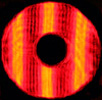June 5, 2016: Upgrading a 16"
All text and images copyright Michael E. Lockwood and/or a third party, all rights reserved.
A client named Matt has done quite a bit of work on his 16" f/4.5 Midnight Telescope to bring it up to modern standards of performance.
He bought the telescope used, and found its performance lacking. While he used the original mirror, he bought a replacement mirror, and sent it to me for refiguring. I refigured the replacement mirror and had it recoated by Carl Zambuto. I also provided a new 3.5" m.a. secondary mirror to replace an undersized 2.6" m.a. flat that came with the telescope but did not quite allow all of the light from the primary to reach the focuser. This is a situation where trying to minimize central obstruction really backfired, or was done on purpose. Read on....

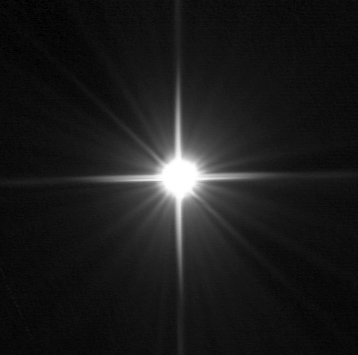
When the new 3.5" m.a. was installed, I had not yet finished the replacement mirror refigure, so the original mirror was still in the telescope. Immediately Matt noticed some strange flaring, scattered light, and "spikiness" to the image, as seen in his image of Sirius (above at right).
As it turned out, the old mirror had a badly rolled edge and surface roughness, as can be seen in the photo of the old mirror (above at left). There is a very bright, broad diffraction ring on the left side, and a variable, much less pronounced one on the right. I don't know how it came about, but it is the source of the spikiness, and the new flat allowed the edge of the mirror to contribute to the image, and allowed the effects of it to be seen in images. Clearly this mirror had to go.
The old mirror was made by someone who I thought knew better, but it was also coated by a coater that is not authorized to coat Lockwood Optics, so I can't say for sure where the rolled edge originated, but either way, it was not performing like it should have.
Matt decided to replace the old spider with an offset version from Gary Wolanski (below left), and he replaced part of the focuser board with thicker baltic birch plywood so that it was stiffer under the load of a heavy binoviewer and eyepieces (below right).
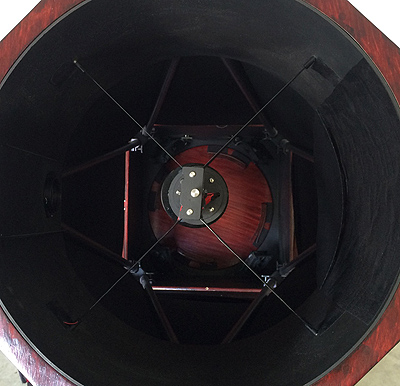
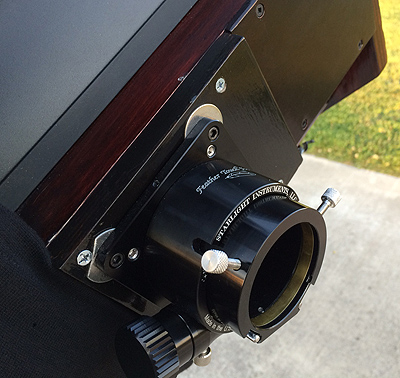
With my recommendation, Matt also bought a new mirror cell from JPAstrocraft. He cut the back out of the old mirror box (not an easy task), touched up the paint, and installed the JPA cell into the mirror box. Here are some images of the old cell, which was a clone of the old Tectron design with a closed back.
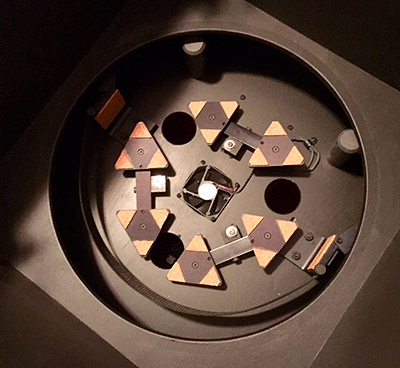
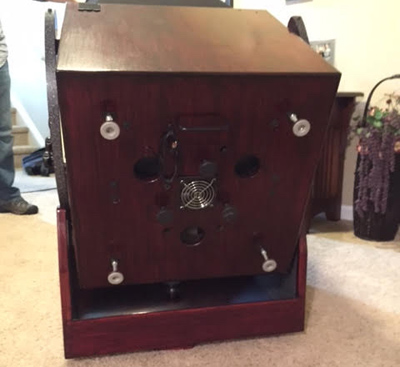
Now Matt has a nice telescope with superb optics and a superb mirror cell. Here are some photos of the preparation for the new cell, and the cell with the mirror in it. Notice the whiffletree and roller edge supports.
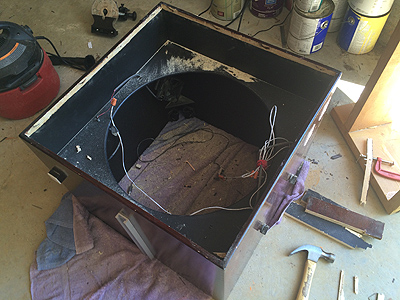
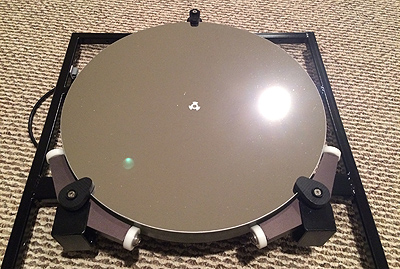
Finally, here is a rear view of the installed cell.
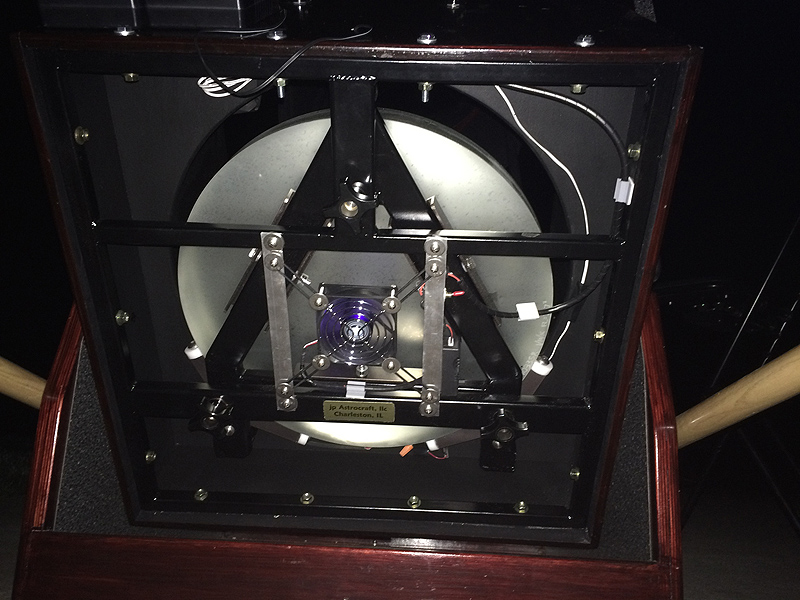
Matt also made some other modifications based on my recommendation, including four front-surface fans that reside in the corners of the mirror box, blowing on the front of the primary. His innovation was to put them on a type of hinge so that they are able to be tilted out of the way so that the secondary cage fits in the mirror box for transport. This is a great solution to cool the front of the mirror. One of the fans can be seen below. For mirrors over ~12", I believe that this method of "scrubbing the boundary layer" is better than the push-pull method because the push-pull fans lose effectiveness over the ~18" to 20" distance across the mirror box, and don't scrub as effectively as four fans that create turbulence right above the mirror's surface.
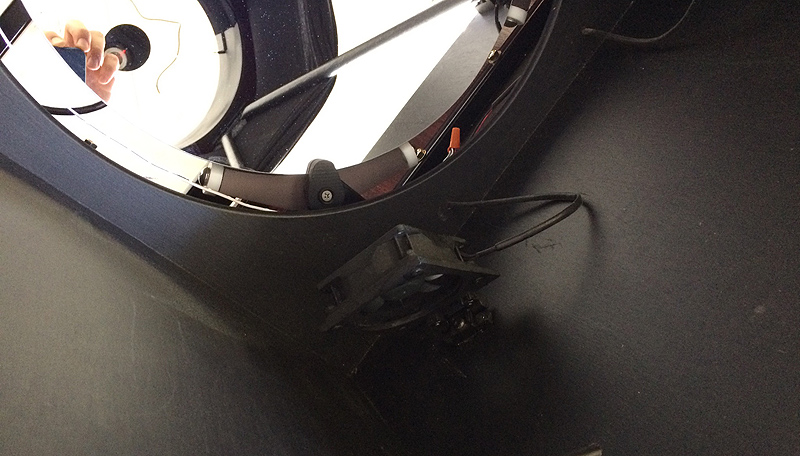
Finally, here is a photo of the telescope with all modifications completed (to be added below).
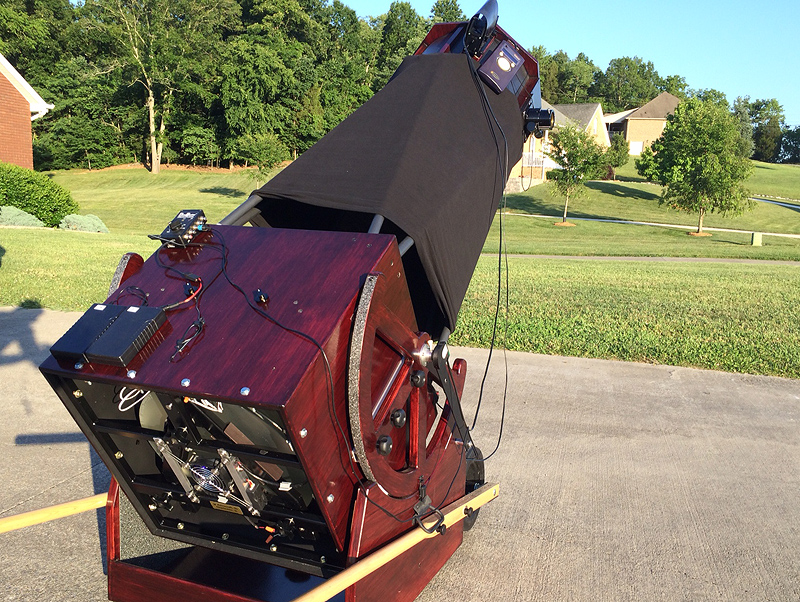
Here are some of Matt's observing comments after the new, refigured mirror was installed. These comments are also found on my Customer Comments page:
"I rolled the scope out for a few quick looks last night. We had a span of about 90 minutes of good seeing around dusk. The moon was spectacular. I can't really even describe it other than to say that it left me speechless. Actually, I'll say that it kind of reminded me of a fractal in that it seemed that looking closer would just keep revealing more details without limit.
I slewed over to Sirius to check collimation and there was the Pup sitting just as plain as day. Capella, being higher in the sky, focused down to a very small, intense point of light. Nothing like the bloated stars that I used to see in my C11. Just a very satisfying, searingly intense little point....."
----
"Sorry to keep emailing you, but OMG. The best view of
Jupiter
that I ever had was through my old TOA 130. Mike, this mirror…
it just guts the TOA. Just slays it.
It’s got all the razor sharpness of the TOA image, but SO MUCH BIGGER,
so much brighter, and so much more color saturated. Jupiter,
just
hanging there in space like I’ve always dreamed of seeing it.
I
would say that I was rendered speechless, but I was actually exclaiming
“HOLY SHIT!” Hope my neighbor was not outside.
This is at 300x and 392x using a Binotron-27. The 2.5”-travel
Feathertouch has sufficient travel for all three power switch positions
to come to focus. It’s just a dream to use. You’d
have to be nuts
to spend what a TOA costs for a visual experience when you could have a
complete 16” scope with Lockwood optics for about the same
price.
Hell, I have THOUSANDS less in my 16” than what a new TOA 130 costs -
and that’s after misadventures and upgrades. For imaging,
sure,
refractors have serious virtue and may well be worth the
money.
For visual? Everyone knows that the big scope will crush a
refractor on DSOs, but
a top-shelf Newtonian operated with a little
care will crush the refractor anywhere the fight goes.
Planets,
lunar, double stars, whatever. I’ve seen this with my 10”
Zambuto
optic and I’m seeing it again with the 16” masterpiece you made for
me. Make mine a Newtonian.
----
Two more nights on Jupiter.... Mike, this mirror is very
impressive. Jupiter looks better than I've ever seen
it.
With most of the scopes that I have previously owned, Jupiter looked
like a white disk with two reddish-brownish stripes. The Red
Spot
could be seen, though usually blurrily. A good night might
reveal
some fracturing or turbulence along the edges of the equatorial
bands. And a really, really good night (>95th
percentile)
might show some blue festoons and smaller barges. But still,
nothing approaching a photographic view.
Through
this 16"
scope,
Jupiter looks like photo, and a good one at that. I always
thought people were exaggerating when they said that, but now I
understand. Last night the seeing forecast for
my area was
4/5. I don't think it was quite that good, but the detail visible on
Jupiter was just stunning. I was using 382x, the highest I
can
achieve with my current eyepiece lineup. And in the short
periods
of best seeing, it was just photographic. Just
photographic. I can't even describe the detail. Look at one of
Chris Go's
better images, that's what it looked like.
I'm
going to have
to get a better short focal length eyepiece. I
now have
optics that justify dropping cash into a high-power eyepiece.
Dropping down to 230x meant that the image was at maximum detail 100%
of the time. This magnification was not sufficient to resolve
the
seeing. However, Jupiter is dazzlingly bright at this exit
pupil.
I said once on Cloudy Nights in one of the silly debates about whether
good optics are worth the money that having a good mirror is like
permanently upgrading the seeing by a couple of levels. And
that's exactly what I'm experiencing with this 16" mirror. None
of these three nights has been remarkable with respect to the seeing
(as I could readily observe twinkling for stars at 35 degrees and
lower), but the Jupiter images I'm seeing are superior to those that I
used to observe even on the best nights with previous telescopes.
I've had this mirror on Jupiter three times. Each time, the
images have been among the best I have ever seen, or *actually* the
best I have ever seen. This type of performance appears to be
routine. And this is exactly what I was hoping I'd get when I
sent the optics to you in the first place. So once I again, I
am
compelled to thank you for your work. It is very much appreciated!"
Here are all the upgrades / mods that I’ve done:
1) Moved the wheelbarrow handle mounting points higher to change the angle, raising the handles. Previously they were only about 3” off the ground, now they are 12” or so. It is much easier to wheel the scope around now, that’s for sure!
2) Replaced the 4k encoders with 10k encoders. Replaced the first generation SkyCommander with Argo Navis. (I may upgrade to Nexus DSC).
3) Power supplied by two 12v 6ah Lithium Ion batteries that ride on the mirror box. No more cord wrap! Power distribution provided via Dewbuster controller riding on mirror box.
4) Boundary layer fans added on motion control hinges. Fans operated via Dewbuster fan speed controllers allowing efficient speed control with no waste heat production. I routed out the mirror box and drilled holes for mounting the controllers
5) Protostar spider replaced with Gary Wolanski offset spider. Astrosystems dew heater nested inside. Secondary replaced with 3.5” model obtained from LCO. (This is when I discovered the nasty edge problem with the old primary mirror, as the previous 2.6” secondary was too small to show the edge of the primary).
6) Flocked the UTA across from the focuser and made a removable light baffle out of flockboard material.
7) Old primary replaced with LCO-refigured optic. You’ve already heard what an improvement this made!
8) JMI focuser replaced with Feathertouch 2.5” travel. (Initially defective; repaired promptly by Starlight Instruments).
9) Tectron-style integrated mirror cell built in to the rear panel of the mirror box replaced by a JP Astrocraft 6-point moving-frame design with wiffletrees and under-mirror cooling package.
Remaining upgrades: replace the thin focuser mounting board using 1/2” Baltic birch; better cable management. Add a removable light baffle for the rear to block light from shining up the tube from the ground. Considering adding a DSC stalk and removing the DSC from the upper cage.
I’ve ended up with a very modern, high-quality telescope. While the truss design is not as advanced as offered by JPA, it works well. The scope holds collimation very well, with *no* movement observed with respect to PAE (as indicated by barlowed laser) from zenith to horizon. The offset spider is very stiff and holds collimation better than any aligned-vane spider I’ve ever used and is also easier to collimate given that the tilt and rotation adjustments are truly independent. The mirror cell is based on the best research available and leaves the whole rear surface of the mirror exposed to ambient air for rapid cooling. The boundary layer fans provide a reduction in cooldown time as well as an observable improvement in image sharpness and scintillation when running by breaking up the boundary layer on the mirror’s surface; as the mirror cools the fan speed can be reduced. The movement is essentially perfect in alt and az, a credit to the original designer, and the alt bearings can be raised or lowered to adjust the balance point — which was crucial given the weight the JPA cell has added to the mirror box!
The scope is not light. I haven’t weighed it, but it is heavy. This is not an issue for me given that I am 35 years old and in good shape. I prefer the stability that comes with the weight.
I always observe using a Paracorr II if I am using single eyepieces or with a Denk Binotron-27 using the OCS-45. Favorite eyepiece currently is my 9mm Baader Morpheus."
This is all valuable information for people who want to get the most out of their telescopes.
Please check back for future installments of "In the Shop".
Mike Lockwood
Lockwood Custom Optics


